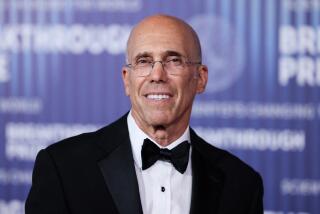NEWS ANALYSIS : Feinstein’s Woes Begin Where Husband’s Signature Ends
- Share via
SACRAMENTO — For the most part, a lawsuit filed last week against Senate candidate Dianne Feinstein’s 1990 campaign for governor focuses on election law violations that can be attributed to mismanagement and sloppy bookkeeping.
But there is one aspect of the Fair Political Practices Commission’s court action--Feinstein’s failure to identify her husband, money manager Richard C. Blum, as co-signer of nearly $2.7 million in loans to her primary campaign--which her critics say raises more disturbing questions.
Did the former San Francisco mayor’s alleged breach of disclosure laws mask a violation of Proposition 73, an initiative then in effect that limited individual contributions to $1,000?
The FPPC lawsuit also underscores Feinstein’s continuing political vulnerability stemming from her financial connections with Blum, an issue that Pete Wilson used effectively against her in winning the 1990 governor’s race.
Feinstein has not been available for interviews since the FPPC, the state’s political watchdog agency, announced the filing of the lawsuit that accused her gubernatorial campaign of misreporting more than $8 million in expenses, loans and contributions. However, a spokesman for her U.S. Senate campaign vehemently denied that there was any wrongdoing in the 1990 campaign.
The key issue in the controversy is the question of community property, a matter that usually figures prominently in contentious divorces and not political races. Under Proposition 73, there was one exception to the $1,000 limit: A candidate could contribute an unlimited amount of his or her personal funds to a campaign. A later FPPC ruling determined that assets the candidate shared with a spouse as community property were also exempt from the limitations.
Critics contend that Blum’s substantial personal assets--those that were not community property--must have played a role in Bank of America’s decision to extend the couple an unsecured line of credit that permitted Feinstein to borrow nearly $3 million for the primary campaign. Under the law at the time, it would have been illegal for Blum to contribute or lend more than $1,000 of his personal funds to his wife’s campaign.
In many marriages all assets are community property, but in the high-profile marriage of Feinstein and Blum they were not. Throughout the 1990 campaign, as questions were raised about potential conflicts between Blum’s business ventures and Feinstein’s political career, the couple steadfastly maintained that they kept their finances separate. They said that Blum’s investment firm, RCBA Inc. (for Richard C. Blum & Associates), was founded before their marriage and was not community property, though the annual income from it was community property.
Feinstein’s spokesman, Kam Kuwata, insisted that the couple was aware of the potential problems with Proposition 73 and scrupulously avoided any use of his funds in her 1990 primary campaign.
“He (Blum) could not legally have put in money over and above the ($1,000) limit,” said Kuwata. “These were her assets from her personal separate property and her assets from their joint community property account. . . . All of this money (used to apply for the Bank of America loan) is her money.”
He said the obligation to repay the loan was solely Feinstein’s and that Blum had been required to co-sign the loans only because some of her assets were community property.
Kuwata said the loans have been repaid by Feinstein from her personal funds.
Political opponents, some of whom filed a 1990 lawsuit accusing the couple of violating Proposition 73, argue that Blum’s personal assets undoubtedly must have figured into the bank’s decision to grant the loan.
“Whenever they require joint signatures, by definition, one person alone can’t qualify,” said Michael B. Montgomery, a City of Industry attorney who handled the lawsuit for the California Republican Party. “If it had all been her separate property then his signature would not have been required.”
Montgomery noted that there were also close business ties between Blum and Bank of America. Kuwata confirmed that Blum’s firm manages $68 million--about 1%--of the outstanding assets of Bank of America.
“It was my impression that they wanted to shield his involvement intentionally because during a majority of the campaign that type of involvement was absolutely illegal under Proposition 73,” said Dan Stanford, a Republican and former FPPC chairman who joined in the 1990 lawsuit.
Kuwata, however, noted that a similar complaint had been filed with the FPPC, which ruled in August, 1990, that it was “unfounded.” A spokesman for the agency said its investigation had not involved an examination of Bank of America loan records.
A Bank of America spokesman said last week that he could not explain the discrepancy because all client records are confidential. “I can’t even confirm we made a loan to a particular customer,” he said.
Speaking only in general terms about bank policy, he said loan decisions take a number of factors into account, including the bank’s knowledge of a client’s business, assets and income streams.
“There is also a subjective aspect to this,” he said, noting that loan making is an art and not a science.
Montgomery said he attempted to subpoena Bank of America records for his lawsuit. But a decision by a federal judge in September, 1990, which threw out the contribution limits set by Proposition 73, made the lawsuit moot.
Of those involved, Montgomery said he felt sorriest for then-Atty. Gen. John K. Van de Kamp, who he said may have lost the election because the loans enabled Feinstein to pay for early TV ads.
“You talk about family money. Van de Kamp’s mother could have put money into her son’s campaign every day if it hadn’t been for Proposition 73,” Montgomery said. The Van de Kamp family made a fortune in the bakery business.
More to Read
Get the L.A. Times Politics newsletter
Deeply reported insights into legislation, politics and policy from Sacramento, Washington and beyond. In your inbox twice per week.
You may occasionally receive promotional content from the Los Angeles Times.










